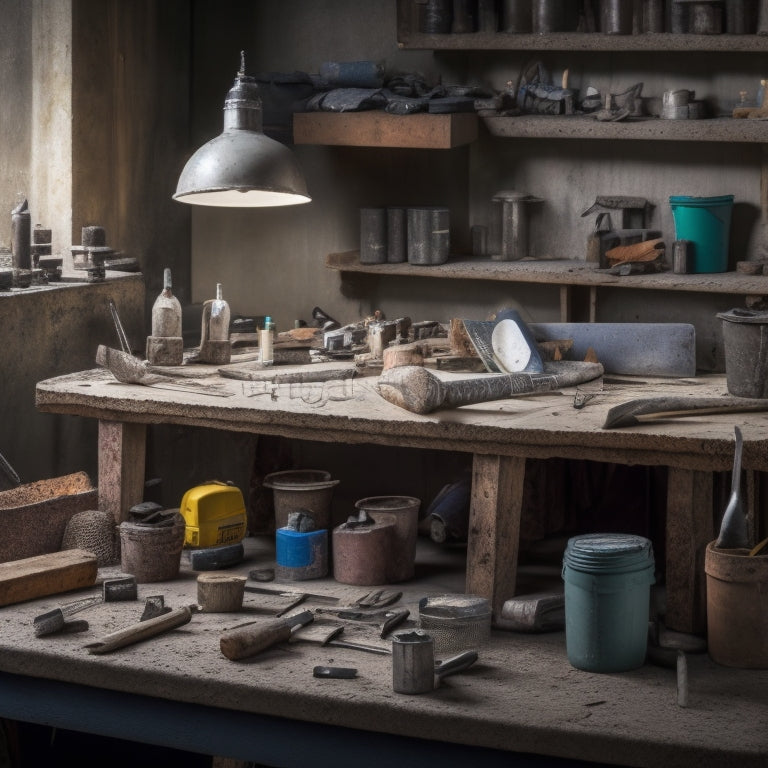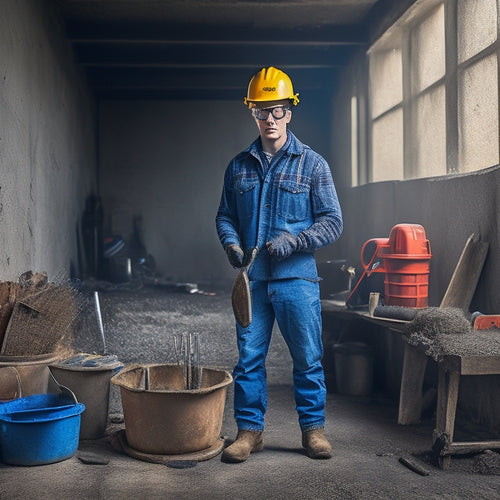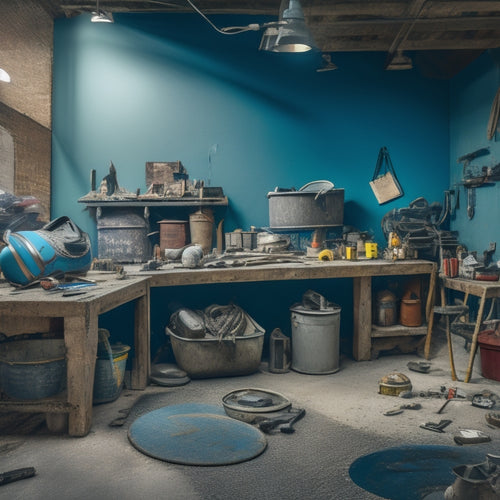
Top Tools for Concrete Repair Success
Share
When it comes to concrete repair success, you'll need a well-stocked toolkit with essential hand tools like trowels, chisels, and hand saws, as well as power tools like saws, mixers, and drills. Measuring and testing equipment, such as moisture meters and surface profilers, will also be vital in ensuring accurate measurements. Safety gear, including eye protection, respiratory protection, and gloves, will keep you protected on the job site. Specialized tools for patching compounds, surface preparation, crack repair, curing, and sealing will also be necessary. Now, explore the specifics of each tool and how they contribute to a successful repair.
Key Takeaways
• Essential hand tools like trowels, chisels, and hand saws are necessary for concrete repair, along with regular maintenance and sharpening.
• Power tools like saws, mixers, drills, and grinders accelerate repair processes, reduce labor intensity, and ensure precise cuts and surface preparation.
• Measuring and testing equipment such as moisture meters, surface profilers, pH meters, and thermometers provide accurate data for informed repair decisions.
• Safety gear including eye protection, respiratory protection, and gloves is crucial for protecting workers from hazards and ensuring a safe working environment.
• Advanced repair systems and techniques like epoxy injection systems, injection equipment, and surface preparation machinery enhance repair effectiveness and durability.
Essential Concrete Repair Hand Tools
You'll need a solid arsenal of essential concrete repair hand tools to tackle most repair jobs, including trowels, chisels, and hand saws. These hand tools are critical for achieving a professional finish and guaranteeing the longevity of the repair.
When selecting your hand tools, consider the type of concrete, the size of the repair area, and the level of precision required. For instance, a pointed trowel is ideal for small, intricate repairs, while a flat trowel is better suited for larger areas.
Proper hand tool maintenance is also important to extend the lifespan of your tools and guarantee peak performance. Regularly clean and dry your tools to prevent rust and corrosion. Store them in a dry place, away from direct sunlight, and apply a rust inhibitor to metal components.
Additionally, perform routine sharpening and honing to maintain the tool's edge. By following these tool selection tips and hand tool maintenance practices, you'll be well-equipped to tackle even the most demanding concrete repair projects.
Power Tools for Faster Repair
When tackling larger or more complex concrete repair projects, incorporating power tools into your arsenal can greatly accelerate the repair process and reduce labor intensity.
By leveraging the right power tools, you'll be able to complete tasks more efficiently and effectively, freeing up time and energy for more important aspects of the project.
Some vital power tools for concrete repair include:
-
Saws: A high-quality saw is key for making precise cuts and removing damaged concrete. Consider your saw selection carefully, as different types are suited for specific tasks and materials.
-
Mixers: With various mixer types available, it's important to choose the right one for your project's specific needs. From heavy-duty concrete mixers to more portable options, the right mixer can greatly impact your workflow.
-
Drills and Grinders: These versatile tools are perfect for drilling into concrete, grinding away imperfections, and preparing surfaces for repair.
Measuring and Testing Equipment
Accurate measurements and tests are essential to guaranteeing a successful concrete repair, and having the right measuring and testing equipment is fundamental to achieving this goal.
As you prepare for your concrete repair project, you'll need to invest in equipment that provides reliable data. A moisture meter is a must-have for measuring the moisture levels in the concrete. This is important because excess moisture can lead to poor bonding between the old and new concrete.
You'll also need a surface profiler to measure surface roughness, which affects the bonding process. Additionally, a pH meter will help you determine the concrete's alkalinity, guaranteeing the right repair materials are used.
Don't forget a thermometer to monitor the temperature of the concrete, as this affects the repair material's curing process. With these measuring and testing tools, you'll be able to collect accurate data, make informed decisions, and achieve a successful concrete repair.
Safety Gear for Protection
As you prepare to tackle concrete repair projects, you'll need to prioritize your safety above all else.
You're about to handle harsh chemicals, heavy materials, and power tools that can pose serious hazards to your health.
To guarantee you're adequately protected, let's cover the essential safety gear you'll need, including eye protection essentials, respiratory defense systems, and glove selection guidance.
Eye Protection Essentials
You must don appropriate eye protection gear to prevent irreparable damage from flying debris, chemical splashes, and other hazards inherent to concrete repair work. As you work with chemicals, power tools, and heavy machinery, your eyes are constantly at risk. Without proper protection, even a minor accident can lead to serious eye injuries or vision loss.
To guarantee ideal protection, consider the following essential features for your eye protection gear:
-
Lens types: Polycarbonate or Trivex lenses offer superior impact resistance and optical clarity. For outdoor work, lenses with UV protection are a must to prevent long-term eye damage.
-
Wraparound frames: These designs provide excellent peripheral protection, reducing the risk of debris sneaking past the lens.
-
Anti-fog coatings: This feature guarantees clear visibility, even in humid or wet conditions, reducing the risk of accidents caused by obscured vision.
Respiratory Defense Systems
Protecting your respiratory system from airborne contaminants, such as silica dust and chemical fumes, is crucial when working with concrete, as even brief exposure can cause long-term health problems.
You'll want to invest in a reliable respiratory defense system to safeguard your health. When selecting a system, consider the type and level of respiratory hazards you'll be facing on the job site.
Look for systems with high-quality filters that can capture 99.97% of particles as small as 0.3 microns. Additionally, consider ventilation systems that can provide a constant flow of clean air, reducing the risk of airborne contaminants.
Don't overlook the importance of proper fitting and maintenance – a well-fitting system can make all the difference in protecting your lungs.
Remember, it's not just about meeting OSHA guidelines, it's about taking proactive steps to guarantee your long-term health and safety.
Glove Selection Guidance
Selecting the right gloves for concrete repair is critical since they're the first line of defense against harsh chemicals, abrasives, and physical hazards that can cause injuries ranging from mild skin irritation to severe lacerations.
You need gloves that provide maximum protection without compromising dexterity or grip performance.
When choosing gloves, consider the following key factors:
-
Chemical resistance: Look for gloves made from materials like nitrile, neoprene, or PVC that can withstand harsh chemicals and abrasives.
-
Grip performance: Gloves with textured palms or fingers can improve grip, reducing the risk of dropping tools or materials.
-
Cut resistance: Gloves with high-cut resistance, such as those made from Kevlar or Dyneema, can protect your hands from lacerations.
Patching Compound Application Tools
Concrete repair professionals rely on a range of specialized tools to accurately apply patching compounds and guarantee a strong, long-lasting bond.
When selecting application tools, you'll want to evaluate the specific patching techniques and compound types you're working with. For instance, if you're using a fast-setting polyurethane compound, you'll need a tool that can keep up with its rapid curing time. A high-flow, low-viscosity applicator gun is ideal for this type of compound, allowing you to work quickly and efficiently.
On the other hand, if you're working with a slower-setting epoxy compound, you may prefer a tool with more control and precision, such as a manual or pneumatic applicator gun with adjustable flow rates.
Additionally, you'll want to assess the size and shape of the area you're repairing, as well as the desired finish. Tools like trowels, putty knives, and squeegees can help you achieve a smooth, even finish.
Advanced Epoxy Injection Systems
You'll often turn to advanced epoxy injection systems when dealing with deeper, more complex cracks and voids that require precision injection and high-pressure delivery. These systems allow you to target specific areas with customized epoxy formulations, ensuring a strong and durable bond.
When selecting an advanced epoxy injection system, consider the following key features:
-
High-pressure pumps capable of delivering up to 3,000 psi to reach deep-seated cracks and voids.
-
Precise injection nozzles for targeted application and minimal waste.
-
Real-time monitoring systems to track injection pressures, flow rates, and material volumes.
Surface Preparation Machinery
Effective surface preparation is essential to ensuring a strong bond between the repair material and the existing concrete, and that's where surface preparation machinery comes in, allowing you to efficiently remove dirt, oil, and other contaminants that can compromise the repair. By using the right machinery, you can achieve the best surface texture for bonding, which is critical for a successful repair.
| Machinery Type | Benefits | Applications |
|---|---|---|
| Shot Blasters | Efficiently removes surface contaminants, profiling the substrate | Large areas, such as warehouse floors or parking garages |
| Scarifiers | Aggressively removes thick coatings, mastics, and epoxies | Preparing surfaces for overlays or coatings |
| Grinders | Provides a high-quality finish, ideal for substrate evaluation | Small areas, such as patching or joint repairs |
When selecting surface preparation machinery, consider the specific requirements of your project, including the size of the area, type of contaminants, and desired surface texture. By choosing the right machinery, you'll be able to achieve a strong bond between the repair material and the existing concrete, ensuring a successful and long-lasting repair.
Crack Repair Injection Tools
When you're tackling crack repair, you'll need to choose the right crack filling method for the job, whether it's epoxy, polyurethane, or another type.
You'll also need to select the appropriate injection equipment to guarantee a successful repair.
In this section, you'll learn about the different crack filling methods and injection equipment options available to help you make informed decisions.
Crack Filling Methods
Concrete repair professionals rely on specialized crack filling methods, including epoxy injection and polyurethane grouting, to restore structural integrity and prevent further damage.
When it comes to selecting the right crack filling method, you need to take into account the type and severity of the crack, as well as the environmental conditions. You'll want to choose a repair material that's compatible with the surrounding concrete and can withstand the expected loads and stresses. For example, epoxy injection is often used for structural cracks, while polyurethane grouting is better suited for non-structural cracks.
When performing crack filling, you'll typically follow these steps:
-
Prepare the crack by cleaning and drying it to guarantee a strong bond
-
Apply the selected repair material, making sure to fill the crack completely
-
Allow the material to cure, following the manufacturer's instructions
Injection Equipment Options
You'll need a reliable injection equipment setup to successfully fill cracks with epoxy or polyurethane, and several options are available to suit your specific repair needs. The right equipment guarantees efficient and effective crack filling, saving you time and resources.
Here are some common injection equipment options:
| Equipment Type | Suitable For | Key Features |
|---|---|---|
| Manual Piston Injectors | Small to medium-sized repairs | Affordable, easy to use, and portable |
| Electric Piston Injectors | Medium-sized repairs | Faster injection rates, higher pressure |
| Pneumatic Injectors | Large-scale repairs | High-volume injection, high pressure |
| Metering Injectors | Precise epoxy formulations | Accurate mixing and metering |
| Portable Injection Kits | On-site repairs | Compact, all-in-one solution |
When choosing an injection equipment setup, consider factors like the size and complexity of the crack, the type of epoxy or polyurethane being used, and the level of precision required. For example, if you're working with polyurethane injections, you may need a higher-pressure injector. By selecting the right equipment, you'll be able to achieve professional-grade results and guarantee long-lasting crack repairs.
Curing and Sealing Equipment
Sealing and curing equipment play a significant role in ensuring the long-term durability and strength of repaired concrete structures.
As a concrete repair professional, you know that proper curing and sealing are essential to preventing water infiltration, reducing shrinkage cracks, and enhancing the overall appearance of the restored surface.
When it comes to curing techniques, you'll need the right equipment to apply and maintain the ideal conditions for concrete hydration. This may include:
-
Curing compounds: Liquid membranes that form a protective barrier on the concrete surface, preventing moisture loss and promoting uniform curing.
-
Curing blankets: Insulating materials that retain heat and moisture, ensuring a consistent temperature and reducing the risk of thermal shock.
-
Curing tents: Portable enclosures that create a controlled environment, shielding the concrete from wind, sun, and other external factors.
Specialized Concrete Finishing Tools
To achieve a smooth, even finish, specialized tools are required to manipulate and refine the freshly poured or repaired concrete, allowing you to tackle complex projects with precision and confidence.
These tools help you master various finishing techniques, from simple smoothing to intricate surface textures. You'll need a range of specialized tools, including tamping tools, edgers, and floats, to achieve the desired finish.
For instance, a bull float is essential for smoothing out large areas of concrete, while a hand float is perfect for tighter spaces. Edgers, on the other hand, help create defined edges and joints.
You'll also need to invest in a set of tamping tools, such as a tamper or a jitterbug, to compact and vibrate the concrete, ensuring it's dense and even.
Frequently Asked Questions
Can I Use a Regular Drill for Mixing Patching Compound?
When it comes to mixing patching compound, you're wondering if a regular drill will do the trick.
While it's tempting to use what you've got, a regular drill isn't the best choice. You'll end up with an uneven mix and potentially damage the drill.
Instead, opt for a drill specifically designed for mixing, such as a paddle mixer or a heavy-duty drill with a mixing paddle attachment.
Employ proper mixing techniques to guarantee a smooth, consistent blend.
How Often Should I Replace My Safety Goggles?
When it comes to goggle maintenance, you should inspect your safety goggles regularly for signs of wear, scratches, or damage.
Replace them every 6-12 months or immediately if you notice any issues.
Proper eye protection is vital, as compromised goggles can fail to protect your eyes from debris and chemicals.
Don't risk your vision - stay vigilant about goggle maintenance to guarantee you're always protected on the job.
What Is the Ideal Temperature for Concrete Repair?
Did you know that the concrete industry produces over 10 billion tons of concrete annually?
When it comes to concrete repair, you'll want to get the temperature just right. The ideal concrete curing temperature ranges from 50°F to 70°F (10°C to 21°C).
Temperature impact is vital, as extreme temperatures can affect the concrete's strength, durability, and overall quality.
You'll want to aim for a consistent temperature to guarantee a strong, long-lasting repair.
Can I Use Epoxy Injection for Hairline Cracks?
When dealing with hairline cracks, you'll want to contemplate epoxy injection as a viable option.
This method offers several advantages, including its ability to effectively fill narrow cracks and provide a strong, durable bond.
Epoxy's low viscosity allows it to penetrate deep into the crack, ensuring a complete repair.
Do I Need to Prime the Surface Before Applying a Sealant?
Are you confident that the surface is ready for a sealant? You shouldn't be.
Proper surface preparation is essential for ensuring a strong bond between the concrete and the sealant. You must prime the surface before applying a sealant to guarantee the best sealant adhesion.
Failing to do so can lead to peeling, flaking, or even complete sealant failure.
Take the time to clean, degrease, and etch the surface to create a strong foundation for a successful repair.
Conclusion
You've got the skills, now it's time to gear up for concrete repair success.
With the right tools, you'll be able to tackle any job that comes your way.
But don't just stop at the basics - invest in the best equipment for the task at hand.
Will you settle for mediocre results or take your concrete repairs to the next level?
By arming yourself with these top tools, you'll be well on your way to delivering high-quality, long-lasting results that will impress even the toughest critics.
Related Posts
-

What Tools Do I Need for Concrete Wall Repair
As you prepare for a concrete wall repair job, you'll need a variety of tools to guarantee a successful outcome. Star...
-

What Tools Do You Need for Concrete Flooring
You'll need a thorough arsenal of specialized tools to achieve a high-quality, professional-looking concrete floor, i...
-

Top Mixing Tools for DIY Concrete Block Laying
When it comes to DIY concrete block laying, the right mixing tools are vital for a strong and durable structure. You'...


